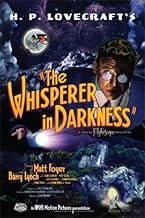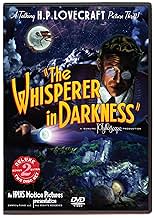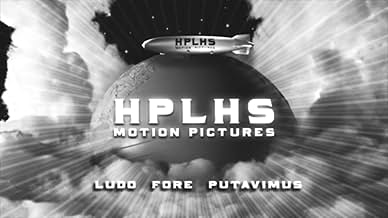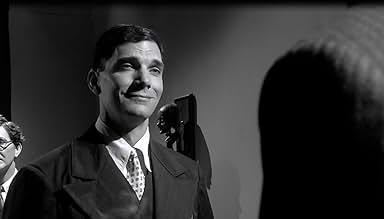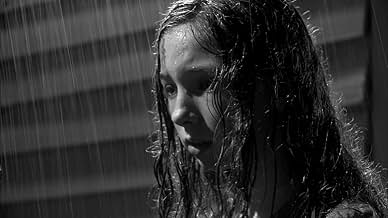CALIFICACIÓN DE IMDb
6.5/10
3.8 k
TU CALIFICACIÓN
Agrega una trama en tu idiomaBased on the H. P. Lovecraft story of the same name, a folklorist investigates reports of unusual creatures in Vermont only to uncover more than he bargained forBased on the H. P. Lovecraft story of the same name, a folklorist investigates reports of unusual creatures in Vermont only to uncover more than he bargained forBased on the H. P. Lovecraft story of the same name, a folklorist investigates reports of unusual creatures in Vermont only to uncover more than he bargained for
- Dirección
- Guionistas
- Elenco
- Premios
- 3 nominaciones en total
Conor Timmis
- Porter
- (escenas eliminadas)
- Dirección
- Guionistas
- Todo el elenco y el equipo
- Producción, taquilla y más en IMDbPro
Opiniones destacadas
The Whisperer in Darkness ranked in the "pretty good" range of Lovecraft adaptations, for me. The higher range would include Re-Animator, From Beyond, and A Color Out of Space, while the lower range would include Beyond the Wall of Sleep and The Deep Ones. The mid-range is populated by such movies as The Unnamable, Dagon, and Necronomicon, and is a fuller list than either of the other ranges of the spectrum. In The Whisperer in Darkness, we are plagued by poor acting by the little girl, and questionable acting by the lead and main antagonist. The special effects range from mid- to questionable, as well. But as an indie movie, it does really well, and way better than I had expected. I highly recommend to Lovecraft fans, as this one definitely held my attention, and I understand people consider it a pretty faithful adaptation.
It is notoriously difficult to bring a Lovecraft story to the screens without reinventing pretty much everything. The reason for that is that the emotional tension in his stories is all based on what he tells you the characters feel. He doesn't really construct a horror environment as much as place people who are easily scared, disgusted or appalled in circumstances that are usually light sci-fi.
Created by the same team that did The Call of Cthulhu in 2005, it is a black and white movie, only this time not a mute one. The story it is based on is also longer, but then so is the movie.
I liked it, but then I kind of understand what H.P.Lovecraft was all about. For other people I think this would be a waste of time.
Created by the same team that did The Call of Cthulhu in 2005, it is a black and white movie, only this time not a mute one. The story it is based on is also longer, but then so is the movie.
I liked it, but then I kind of understand what H.P.Lovecraft was all about. For other people I think this would be a waste of time.
Really enjoyed the clean look of this film in black & white, and also the sound editing. This is probably the classiest example of what can be achieved with a limited budget when the filmmakers obviously have a love of the material which shines through. The script is faithful to Lovecraft yet it does cuts down on a lot of the excessive verbiage to make it somewhat more palatable to a modern audience. The pace progressively builds and does pay off. The standout performance is from the adorable Autumn Wendell "Hanna Masterson" who embodies the film and is very effective at being terrified, yet innocent at the same time. A perfect fit to a film which achieves the same things.
One cannot help but give full marks to the H.P. Lovecraft Historical Society for their efforts to bring H. P. Lovecraft's eerie stories to the screen in a manner in keeping with the texture and mood of the original material. Although there have been other attempts to film Lovecraft stories, most have generally been unsatisfying failures due to misguided attempts to modernize or glamorize them. Not so with HPLHS, who have gone out their way to keep faithful to the period and locales in which the tales were set, even going so far as give the film the feel of an early-1930s black-and-white movie. Even their logo is an homage to the the old Universal Studios logo of the early 1930s (the studio which produced such classic horror movies as Frankenstein, Dracula and The Mummy), replacing the familiar airplane-circling-the-earth with a dirigible.
The plot involves Albert Wilmarth, a college anthropology professor specializing in folklore, who becomes intrigued by a series of unusual newspaper stories reported from a rural part of Vermont after a period of particularly heavy rains. It seems that bodies have been observed washing down from the mountains in the swollen rivers, bodies which are, reportedly, neither human nor animal. The bodies apparently also recall, among the older inhabitants, old tales of strange beings that live in remote parts of the hills, beings that are neither human nor animal, and possibly not even of terrestrial origin. Wilmarth begins his investigation into these stories on the basis that they are nothing more than mere interesting folklore, but soon finds himself dealing with something far more sinister.
Admittedly, the producers of the movie added some material and characters not present in the original story. In fact, the short story actually ends at a point only about one hour into the film. However, the original version was, after all, only a short story, and I suppose the makers felt that they had to add some material to the plot in order to expand the short story into a full-length movie. nevertheless, the movie still does a far better job of evoking the feel of H.P. Lovecraft's writing than any other movie versions of his works, with the only possible exception being the resent silent film version of The Call of Cathulhu, which was made by the same producers.
One addition to the film is a debate staged between the protagonist, Professor Wilmarth, and Charles Fort. While that was not a part of H.P. Lovecraft's original story, it is interesting period touch because Charles Fort was actually a real person, a celebrated and controversial author of the early 1900s who was known to contemporaries as "The Mad Genius of the Bronx". Fort, who died in 1932, wrote about what are now called paranormal phenomena before that term was even invented, and is credited, among other things, with coining the word "teleportation".
The plot involves Albert Wilmarth, a college anthropology professor specializing in folklore, who becomes intrigued by a series of unusual newspaper stories reported from a rural part of Vermont after a period of particularly heavy rains. It seems that bodies have been observed washing down from the mountains in the swollen rivers, bodies which are, reportedly, neither human nor animal. The bodies apparently also recall, among the older inhabitants, old tales of strange beings that live in remote parts of the hills, beings that are neither human nor animal, and possibly not even of terrestrial origin. Wilmarth begins his investigation into these stories on the basis that they are nothing more than mere interesting folklore, but soon finds himself dealing with something far more sinister.
Admittedly, the producers of the movie added some material and characters not present in the original story. In fact, the short story actually ends at a point only about one hour into the film. However, the original version was, after all, only a short story, and I suppose the makers felt that they had to add some material to the plot in order to expand the short story into a full-length movie. nevertheless, the movie still does a far better job of evoking the feel of H.P. Lovecraft's writing than any other movie versions of his works, with the only possible exception being the resent silent film version of The Call of Cathulhu, which was made by the same producers.
One addition to the film is a debate staged between the protagonist, Professor Wilmarth, and Charles Fort. While that was not a part of H.P. Lovecraft's original story, it is interesting period touch because Charles Fort was actually a real person, a celebrated and controversial author of the early 1900s who was known to contemporaries as "The Mad Genius of the Bronx". Fort, who died in 1932, wrote about what are now called paranormal phenomena before that term was even invented, and is credited, among other things, with coining the word "teleportation".
It is so hard to find a good Lovecraft movie. But this one is excellent. It does not rely on cheap jump scares or the like. It builds up a creepy atmosphere that scares you by suggesting the unimaginable otherworldly. Just like Lovecraft, it presents a vision of superior forces beyond the control of humanity. The acting is great and the screenplay is very fluid. The set design is amazing as well. Sadly, the digital effects are rather noticeable and cheap. Especially on the creatures. I would have really liked to see some good old stop motion, especially on a film that looks so eerily like an old 30s or 40s horror movie.
¿Sabías que…?
- TriviaCharles Fort (1874-1932) was a real person, a collector of accounts of unusual phenomena, disdaining scientists who would try to explain it all away, as seen in the film.
- ErroresWhen Professor Wilmarth is waiting for young Mr. Akeley at the Boston train station, Wilmarth turns his head to see that the train is approaching. Although the image is out of focus, it is clearly a modern train, not one that would be seen in the 1920's.
- Créditos curiososAfter the FBI copyright warning: "all video involving fungal beings from the farther reaches of the solar system is carefully monitored by the Mi-Go, who deal harshly with those who duplicate and upload to the internet without permission."
Selecciones populares
Inicia sesión para calificar y agrega a la lista de videos para obtener recomendaciones personalizadas
- How long is The Whisperer in Darkness?Con tecnología de Alexa
Detalles
- Tiempo de ejecución1 hora 43 minutos
- Color
- Relación de aspecto
- 1.78 : 1
Contribuir a esta página
Sugiere una edición o agrega el contenido que falta

Principales brechas de datos
By what name was The Whisperer in Darkness (2011) officially released in India in English?
Responda

